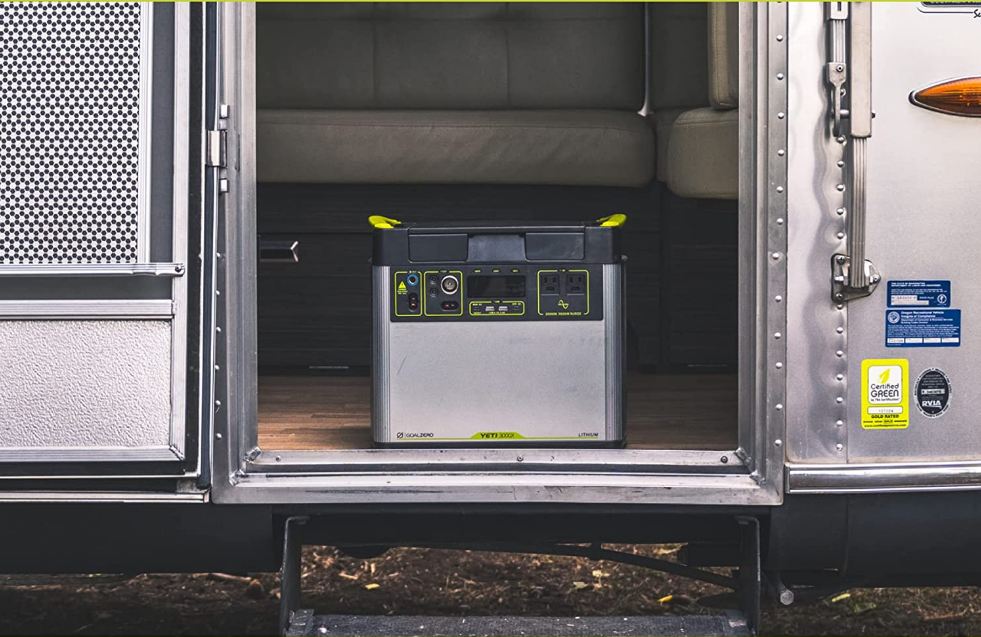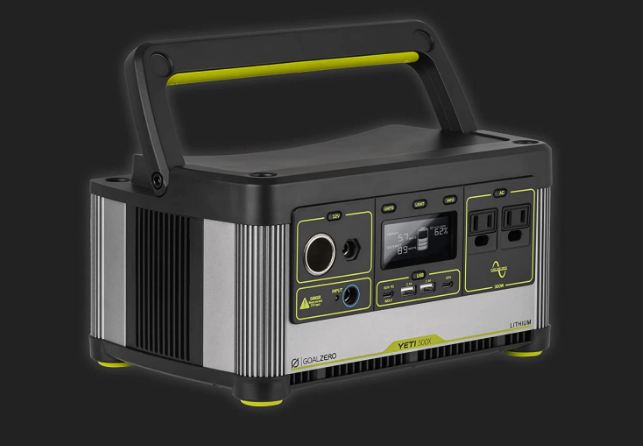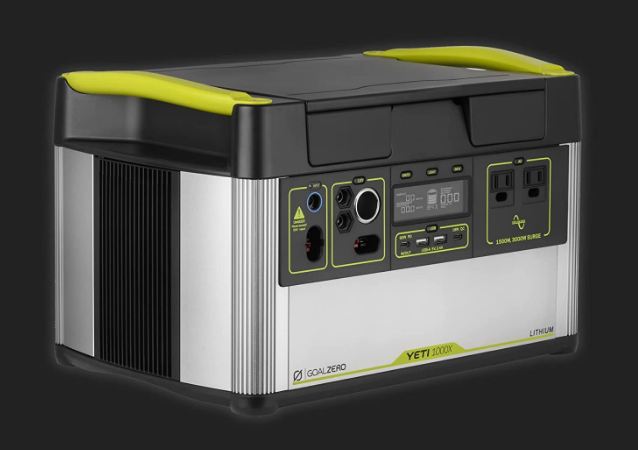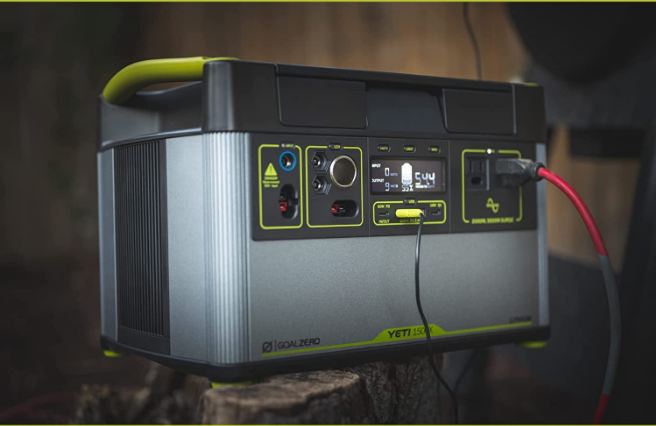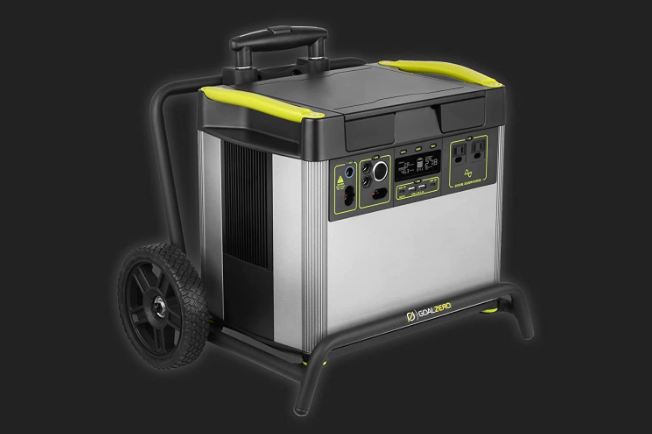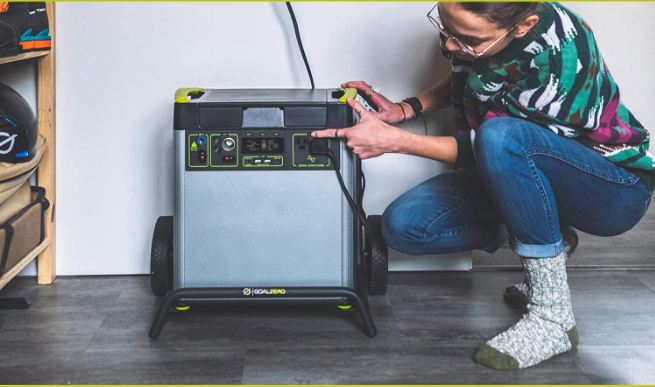Goal Zero is one of the best known brands when it comes to solar generators. It was one of the first companies to introduce portable solar power stations.
If this is the first you are hearing of Goal Zero or you don’t know much about them, check out this post I wrote explaining who Goal Zero is, what they sell and whether you can trust their products.
In this post, I focus on the Goal Zero Yeti solar generators, including what I like and don’t like about them and how they compare to other brands like Bluetti and Jackery.
Goal Zero Yeti Solar Generators Compared
There’s a wide range of Yeti power stations starting from the ultra-portable Yeti 200X to the massive Yeti 6000X.
Whether you are looking for a portable solar generator for camping, a solar generator for your RV or camper van, or home backup solar generator, you’ll probably find what you are looking for in the Goal Zero Yeti lineup.
Here’s how the different models compare.
You can see from the table that the Yeti solar generators fall into two major categories. There are the ultra-portable ones that are extra light but not quite as capable. These are the Yeti 200X and Yeti 500X.
Then there are the more powerful and higher-capacity models that weigh more, have more outlets, and are expandable. These are the Yeti 1000X to the Yeti 6000X.
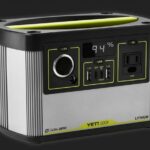
Yeti 200X
187Wh capacity
Expandable:
No120W output
Output:
1xAC, 4xUSB, 2x12V DCInput:
100W max 8mmSize:
7.9 x 5.1 x 5.1 in, 5lbs
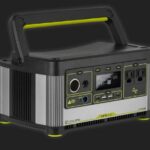
Yeti 500X
505Wh capacity
Expandable:
No300W output
Output:
2xAC, 4xUSB, 2x12V DCInput:
150W max 8mmSize:
7.5 x 11.25 x 5.8 in, 12.9lbs
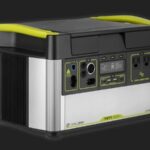
Yeti 1000X
983Wh capacity
Expandable:
Yes1500W output
Output:
2xAC, 4xUSB, 5x12V DCInput:
150W max 8mm, 600W max HPPSize:
15.25 x 10.23 x 9.86 in, 31.7lbs
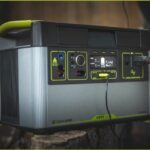
Yeti 1500X
1516Wh capacity
Expandable:
Yes2000W output
Output:
2xAC, 4xUSB, 5x12V DCInput:
150W max 8mm, 600W max HPPSize:
15.25 x 10.23 x 10.37 in, 45.6lbs

Yeti 3000X
3032Wh capacity
Expandable:
Yes2000W output
Output:
2xAC, 4xUSB, 5x12V DCInput:
150W max 8mm, 600W max HPPSize:
15.25 x 10.23 x 13.6 in, 69.8lbs
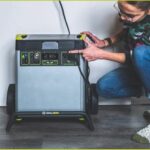
Yeti 6000X
6071Wh capacity
Expandable:
Yes2000W output
Output:
2xAC, 4xUSB, 5x12V DCInput:
150W max 8mm, 600W max HPPSize:
15.3 x 10.1 x 17 in, 106lbs
Goal Zero Yeti 200X
The Yeti 200X is the best choice if you are shopping for a highly portable Goal Zero power station for camping and outdoors.
Being the smallest Yeti, the 200X weighs just 5 pounds, light enough that you can even hike with it from your car to the campsite.
The compromise is that you can only run small appliances and electronics. Really, the Yeti 200X is mostly ideal for keeping your devices charged and powering small electronics like lights, a fan, compressor and maybe a car fridge.
It produces just 120W of AC power and has a capacity of 187Wh. It has a single AC outlet, a 120W 6mm 12V port, a 120W 12V car port, and four USB ports.
The USB ports include a couple of USB-A outlets, an 18W USB-C port and a 60W USB-C PD port. So most devices, including laptops and tablets are covered.
As for recharging, the Yeti 200X has a single 8mm input port that accepts up to 100W of solar power. The included 60W AC charger takes 4 hours to recharge the 200X from a wall outlet.
Goal Zero Yeti 500X
If you need a highly portable power station with a bit more power and capacity, get the Yeti 500X.
It’s next in line after the 200X with a capacity of 505Wh and an AC output of 300W. It’s still limited to small appliances like a mini fridge and CPAP, but you can power them for longer.
The same kind of outlets on the 200X are also available on the Yeti 500X. The main difference is that the AC ports produce more power and there are two of them instead of one.
The Yeti 500X weighs 12.9lbs, so it’s still a great choice if you want a power station you can travel with. I recommend it mostly for campers who want to power more appliances or travel with lots of devices they need to keep charged.
Goal Zero Yeti 1000X
The Yeti 1000X is the first of the big Goal Zero solar generators. It offers a lot more power and capacity than the 200X and 500X.
It’s a great pick if you want a Goal Zero power station powerful enough for home backup but portable enough for camping and outdoor adventures.
The Yeti 1000X has a capacity of 983Wh and the inverter produces 1500W of continuous AC power. So it can power most household appliances in the US including a coffee maker, microwave and TV.
It weighs 31.7lbs. It’s certainly not as light as the smaller Yeti power stations, but most people can still handle it on their own. You should have no problem moving it around the house, in and out of an RV or from your truck to the tent when camping.
The Yeti 1000X has the same number of AC ports (two) and USB ports (four) as the Yeti 500X. But it increases 12V ports to five.
These include two 6mm ports for small 12V electronics like WiFi routers, a 160W car port, and two 180W 12V high power ports.
In addition to the standard 8mm charging port, the Yeti 1000X also includes a high power port (HPP) that accepts up to 600W of solar power.
The included 120W AC adapter recharges the Yeti 1000X in 9 hours.
Goal Zero Yeti 1500X
Want to power bigger appliances or more appliances at the same time?
The Yeti 1500X is the first in the lineup to have a 2000W AC output. It’s more than capable of running almost any household appliance.
With a capacity of 1516Wh, you can power appliances for longer and recharge devices more times.
You get the same number and type of outlets available in the Yeti 1000X including two AC ports and five 12V ports. However, the Yeti 1500X has more capable 360W high power 12V ports to support larger 12V electronics.
Input ports are also similar: an 8mm port with a max 150W input and a HPP port with a max 600W input.
You also get the same 120W charger that’s included with the Yeti 1000X. But because the 1500X has a bigger battery, charging takes longer - 14 hours.
Like the Yeti 1000X, the 1500X balances between portability and performance. It weighs 45.6lbs.
You can keep it at home for backup or in your RV/boat to power appliances, but it’s also great for use on the move during road trips, truck camping or overlanding.
But I recommend using it while it’s in the truck. Hauling it on and off the vehicle is a tedious 2-person job.
Goal Zero Yeti 3000X
Goal Zero makes a big leap in battery size from the 1500X to the 3000X. The Yeti 3000X doubles in capacity to 3032Wh, making it a good pick for home backup and off-grid power.
Of course, it also gets a lot heavier. It weighs 69.8lbs. I don’t recommend it for any situation where you have to move it around a lot.
Power output stays the same as the 1500X at 2000W. You also get the same number and type of outlets and input ports.
The Yeti 3000X comes with a more powerful 230W charger, but it still takes an awful long time to recharge - 14 hours.
Goal Zero Yeti 6000X
Finally, there’s the biggest of them all, the Yeti 6000X, which is double the size of the Yeti 3000X.
At 106lbs, it’s probably a stretch to call the Yeti 6000X portable. It’s portable in the sense that it’s not permanently fixed in place. You can wheel it around on the included cart.
The large 6071Wh capacity of the 6000X makes it the best Goal Zero solar generator for home backup. You can power essential appliances for hours or days during a blackout.
It’s also a great choice for off-grid power in an RV, boat, outdoor shed or cabin.
What I don't like so much about the Yeti 6000X is that it’s limited to 2000W output like the Yeti 1500X and 3000X.
Despite the large capacity, you cannot run more than a couple or so appliances at the same time.
It would have also been nice if the Yeti 6000X had a higher solar input for faster solar charging. It has the same 600W HPP input port as the other large Yeti power stations.
The Yeti 6000X does come with a powerful 600W AC charger, but because the battery is massive, it takes 12 hours to recharge.
What We Like About Yeti Solar Generators
Here are the areas where the Yeti solar generators get it right.
What We Don’t Like About Goal Zero Yeti Solar Generators
Here are the areas we think Goal Zero could do better.
Goal Zero Yeti vs. Jackery Solar Generators

Jackery focuses mostly on making highly portable solar generators for camping and outdoor adventures. Their largest model is the Jackery Explorer 2000 Pro with a capacity of 2160Wh and an output of 2200W.
But they have many ultra-portable models including the Explorer 160, Explorer 240 and Explorer 500.
Jackery solar generators are generally lightweight and easy to take on the road. For instance, the Explorer 2000 Pro weighs 43 pounds, meaning it’s lighter than the smaller Yeti 1500X.
The Jackery Explorer 500 weighs about the same as the Yeti 500X, but it has a more powerful 500W inverter and a slightly bigger battery.
Price-wise, Jackery power stations are generally cheaper. Goal Zero Yeti solar generators are some of the most expensive in the market.
Another thing we love about Jackery is that they have started introducing faster charging power stations. The new Explorer 1000 Pro and 2000 Pro charge super fast with either solar or the included AC charger.
The main limitation of Jackery power stations is their limited lifespan Li-ion batteries. On the upside, these batteries are important in keeping the power stations light and portable (LiFePO4 batteries last longer but are heavier).
Jackery power stations are also not expandable. But again, you probably don't want to get additional batteries that will add more weight.
If you want a solar generator specifically for home backup, stick with Goal Zero or consider EcoFlow or Bluetti.
You can still use Jackery power stations for home backup; just keep in mind that you cannot expand capacity.
Goal Zero Yeti vs. Bluetti Solar Generators
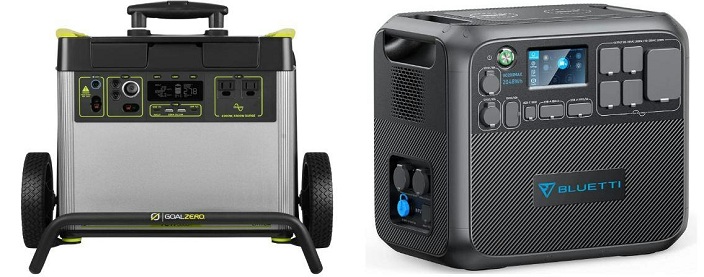
Bluetti is a newer Chinese brand that sells high-tech and affordable power stations. Two of their most popular models include the AC200P and AC200MAX.
One of the things that makes Bluetti different from Goal Zero is that they use LiFEPO4 batteries in most of their power stations. These can last over 3000 cycles to 80% capacity and have an overall lifespan of 5-10 years.
Bluetti power stations also offer a wide range of outlets, including special outlets like RV ports. And when it comes to recharging, you also have plenty of options including dual AC and dual AC/solar charging.
This helps speed up charging.
But I think the biggest advantage of Bluetti power stations over Goal Zero is value for money. Bluetti offers powerful and high-capacity solar generators with tons of features for a lower price than Goal Zero.
Goal Zero Yeti vs. EcoFlow Solar Generators
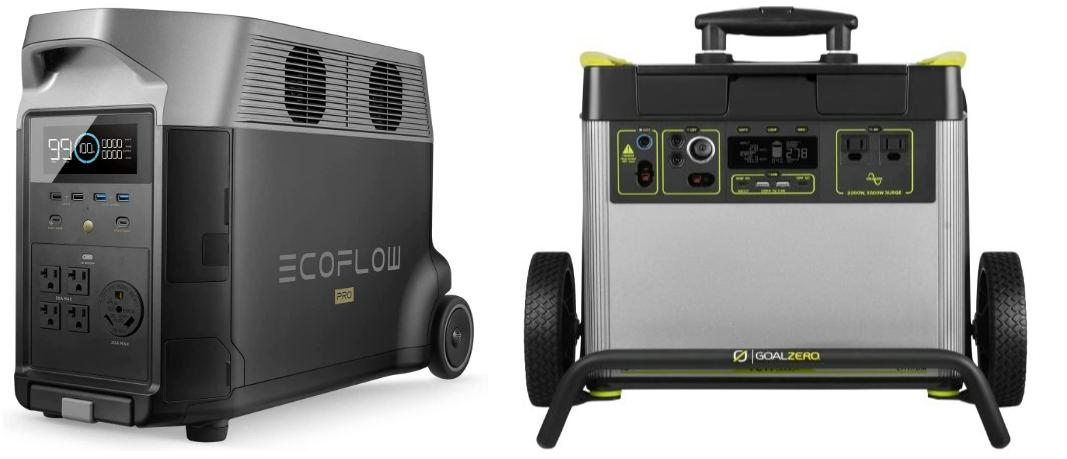
If you hate the slow charging of Goal Zero power stations, EcoFlow solar generators are the best alternatives.
Almost all of them come with X-Stream charging technology that recharges them really fast, usually in less than 2 hours. And unlike Goal Zero, you don't need to buy a special charger or adapter to enjoy fast charging.
EcoFlow also offers a wide range of outlets and input options (including EV station recharging for some models).
Some of their models like the Delta Pro and Delta 2 have long-lasting LiFePO4 batteries.
Final Thoughts
Here’s my bottomline on Goal Zero Yeti solar generators: they are great and are well built. But they are starting to get dated.
You can get more advanced power stations from other brands with cool features like dual charging, high solar power input, RV ports, wireless charging pads, long lifespan LiFEPO4 batteries and more.
The slow charging speeds (both solar & AC) is an especially big concern. I also think you can get better value for your hard earned money with other brands like EcoFlow, Jackery and Bluetti.

